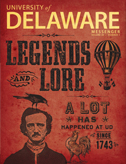Putting a brake on HIV

CAMPUS | A shift in perspective turned out to be a key step for UD scholars who helped uncover a groundbreaking mechanism for potentially defeating the human immunodeficiency virus (HIV), which has killed 35 million worldwide.
After spending seven years studying every atomic twitch and shudder of the microbe, the research team from UD and several other universities found that administering the right chemical at the right time can short-circuit the virus’ ability to cloak itself in a protective shell, rendering it harmless. Their work answered a longstanding question about how the final step in the maturation of the virus occurs—a process in which a noninfectious immature virion turns into an infectious virus particle.
The next big step is to fine-tune the treatment for use in human patients, but for now, UD’s Department of Chemistry and Biochemistry is basking in worldwide acclaim for the discovery, which relied on the University’s expertise in nuclear magnetic resonance spectroscopy—a technology that can pinpoint every atom in an object and see how each one moves.
“People used to be fixated on the static structures of viruses, but they are not rock solid,” says Tatyana Polenova, a professor of chemistry and biochemistry who was part of the project. “Viruses like HIV and their constituent molecules are dynamic entities that are constantly expanding and shrinking. Their motions are like breathing.”
In this case, close examination of the “breathing” showed that there were fleeting micro-moments where drugs could interfere with the mechanism that snips the building blocks of the virus’ coat. The discovery involved many scientific sub-specialties and much cross-disciplinary cooperation, including groundbreaking work by quantitative biophysicist and assistant professor Juan Perilla.
As a postdoctoral scientist at the University of Illinois, Perilla created the first structural models of HIV. Today, at UD, he routinely uses some of the world’s largest supercomputers to generate simulations of the HIV virus and its many moving parts.
“This work would be impossible without our combined strength,” says Polenova.



